VAPORIZATION
FROM: America’s Reaction to the Atomic Bomb
“Any object within a two kilometer distance from the hypocenter suffered significant burn damage, and those located near the hypocenter were instantaneously vaporized. The Shima hospital, the hypocenter of the atomic bomb was vaporized, along with all her patients.” [Hiroshima]
http://users.dickinson.edu/~history/product/steele/seniorthesis.htm
Yukiharu did not realize at first that a bomb had exploded. He thought there had been an electrical accident at the plant building he was working in. Then it suddenly became dark and “I heard a huge explosion. The roof of the building had collapsed, and we were under the broken roof. I felt a pain in my head. I managed to escape from the building. I did not know what was happening to us, because we had not experienced any serious bombing. . . . I was not badly hurt. . . . A piece of broken glass was sticking into my head.” [Nagasaki]
http://users.dickinson.edu/~history/product/steele/seniorthesis.htm
Patricia Ondrovic Interview – Motorola Radio Troubles and Cellphone Problems
KT: After you witnessed the explosions in the lobby of the WTC 6, you started running in which direction and then what happened?
PO: I kept running west on Vesey. I got hit with the cloud shortly after being turned away from 6 WTC. I was probably at the corner of Vesey/West Street at that point running. I ran towards the West Side Highway — there is a park area there. I remember running across grass and there was now lots of grey and black smoke. I was just trying to get to the water because nothing was exploding, or on fire from what I could see. There were lots and lots of people also running that way at this point.
KT: When were you able to escape the dust cloud and what happened after that?
PO: I was now at the water’s edge. There were no boats I could see, so I started to run north along the side of the West Side Highway. I was about 9 or 10 blocks north of Vesey on the West Side Highway. I found the first FDNY EMS vehicle and knew the crew as they were also from my station. I remember not being able to breathe so well — felt like someone was standing on my chest. When I looked back, I could see people coming out of the black cloud and continuing to run and walk north on the West Side Highway as well.
KT: Did you notice any firefighters or other rescuers having technical problems with their Motorola radios or any other equipment?
PO: Oh yeah, at one point there was a loud “buzzing” sound and none of the EMS radios worked for maybe 30 seconds? We all used Motorola radios and I believe our repeaters were on top of the towers, so when the tower came down our radios failed. I tried to use my cellphone, but that too did not work.
KT: Do you know if anybody’s cellphone worked and were able to get through to anybody?
PO: A few of my co workers had Nextel phones. Theirs worked, but they couldn’t talk to anyone who didn’t have a Nextel because all the other services were out at the time.
http://killtown.blogspot.com/2006/02/911-rescuer-saw-explosions-inside-wtc.html
RUSTING and OXIDATION
Anatomy of a fire
Combustion is the self-sustaining process of rapid oxidation of a fuel being reduced by an oxidizing agent along with the evolution of heat and light. Fires are defined by their physical characteristics. They may vary from very slow oxidation, as in rusting, to very fast oxidation, such as detonations and explosions.
Nuclear Heat Energy
Nuclear Fission and Fusion – The heat generated by either the splitting or combining of atoms.
http://www.lbfdtraining.com/RTM/Chapter3%20Fundamentals/Fire%20Behavior%20&%20Chemistry.html
oxidation–reduction reaction
also called redox reaction any chemical reaction in which the oxidation number of a participating chemical species changes. The term covers a large and diverse body of processes. Many oxidation–reduction reactions are as common and familiar as fire, the rusting and dissolution of metals, the browning of fruit, and respiration and photosynthesis—basic life functions.
http://www.britannica.com/eb/article-9110112/oxidation-reduction-reaction
Chemical vs nuclear burning
Question – How does the sun keep burning when there is no
oxygen? My student asked me this. I talked with him about nuclear
reactions. He looked up fire in the World Book. He found that fire
needs oxygen, fuel and heat. Can you explain this? Thank you. Rise
P., teacher, Bloomington, IN
————————————————
The definition that you were looking at is, narrowly, chemical burning in
air. Fire, more formally, is the phenomenon of atomic (molecular)
recombination that is manifest by a new product and electromagnetic
radiation. Chemical combustion just rearranges the atoms from parent
material(s) to product material(s). The radiation given off is often light
or infra-red (heat). Note that this does not require oxygen. Oxidation
reactions are remarkably common, but by no means the only way to do this.
In nuclear burning, the atoms themselves are combined to create new and
different atoms. Nuclear burning does not require oxygen. The main
nuclear burning that is happening on the sun is a hydrogen-hydrogen
process, forming helium. There are other processes, too, but this is the
main one.
http://www.newton.dep.anl.gov/askasci/gen01/gen01159.htm
11 Steps to Survival
Know the Effects of Nuclear Explosions
A nuclear explosion releases vast amounts of energy in three forms:
- Light and heat
- Blast
- Radiation
The amount of energy released depends upon the size and design of the weapon. A wide range of weapons and delivery systems are available to an aggressor and we have no way of knowing what size of explosions might take place in Canada. For illustration purposes, we describe in this pamphlet the effects of a 5-megaton H-bomb equal to the explosive force of five million tons of TNT. Such a bomb could substantially damage the largest city.
The effects depend upon whether the weapon is exploded high in the air, or on, or near the ground. An air burst usually produces more fire and blast-damage than a ground burst which results in a big crater and more radioactive fallout. The effects described below are approximate for a 5-megaton explosion and can only be approximate since effects depend upon a number of conditions such as weather, terrain, etc.

Air burst

Ground burst
Light and Heat
A blaze of light brighter than the sun is produced by a nuclear explosion. It lasts for about 15 seconds. Temporary blindness and eye injury can result from the glare if eyes are not shielded. The heat rays from the explosion travel at the speed of light or about 186,000 miles per second. It can start fires up to 20 miles away. Many fires are caused when the heat pulse comes through a window to set fire to curtains, paper, clothing and furniture. The heat flash also can set fire to the outside of wooden buildings.
The following are some examples of the predictable effects on unprotected skin of the heat flash of a 5-megaton weapon exploded on a clear day:
- Skin is badly burned up to 15 miles from the explosion.
- Skin is blistered up to 18 miles from the explosion.
- Sunburn types of burns up to 23 miles from the explosion.
Nuclear explosions in the air rather than on the ground are more likely to produce a greater number of serious burns through the heat flash. Clothing will give some protection. A shield between you and the light will give protection against burns from the heat flash.

Effects on Buildings
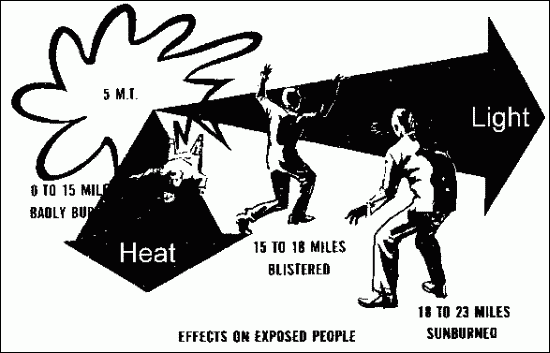
Effects on Exposed People
Blast
The blast wave travels more slowly than the heat flash. Several seconds may pass after you have seen the light or felt the heat before the blast wave reaches you, depending on the distance you are from the explosion. It is like the time between seeing the flash of lightning and hearing the sound of thunder. For example, at ten miles from the centre of an explosion, it would take about 35 seconds for the blast wave to reach you. If caught in the open during a nuclear explosion, this time can be used to find some protection from the blast wave.
You might be injured by being thrown about by the blast; therefore, keep low. The greatest danger is from flying glass, bricks and other debris. The blast from a 5-megaton explosion could injure people as far away as 15 miles.
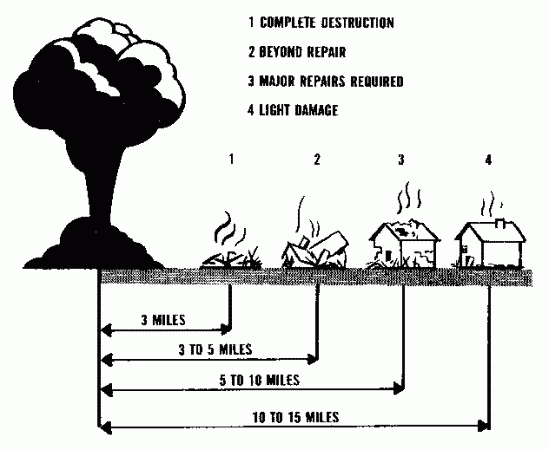
Blast
The kinds of damage that the blast can do to buildings are:
–Complete destruction of all buildings three miles from the centre of the explosion.
–Damage beyond repair to buildings three to five miles distant. They would have to be torn down.
–Major repairs required to buildings five to 10 miles distant before they could be occupied.
–Light to moderate damage to buildings 10 to 15 miles distant. They could be occupied during repairs.
A 20-megaton bomb increases the approximate ranges of damage described above to five, eight, sixteen and twenty-four miles.
These are approximate distances as the strength of buildings is not uniform. For example, reinforced concrete buildings are more blast resistant than wood frame structures. In some areas four miles away from the explosion, concrete buildings might be repairable, while wood frame buildings would be completely destroyed. Windows, of course, are very vulnerable and are apt to be blown in as far away as 25 miles from the explosion.
Radiation
A nuclear explosion causes both immediate radiation and residual radiation. Immediate radiation is given off at the time of the explosion.
It is dangerous only within two or three miles. If you were near the explosion without adequate protection and managed to survive the effects of blast and fire, you could still be seriously affected by immediate radiation.
Residual radiation is given off by the radioactive particles left as “fallout” after the explosion. The danger from fallout would be so great and widespread that it is discussed separately, in >Step 2.
Protection against Heat, Blast and Immediate Radiation
The illustrations below show some of the most probable situations in which you might find yourself at the time of a nuclear attack, and what you should do:
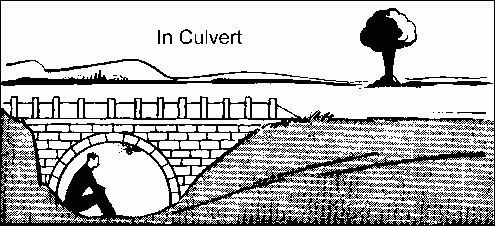
Protection against Heat, Blast and Immediate Radiation
Step 2: Know the Facts About Radioactive Fallout
If a nuclear weapon is exploded on, or near, the ground, danger from radioactive fallout is greatest. The force of the explosion may make a crater up to a mile wide and to a depth of one hundred feet. Millions of tons of pulverized earth, stones, buildings and other materials are drawn up into the fireball and become radioactive. Some of the heavier particles spill out around the point of explosion. The rest are sucked up into the mushroom cloud.
This radioactive material is then carried by winds until it settles to earth. This is called “Fallout”. Under some circumstances you may see the fallout; under others you may not.
The radioactivity it gives off cannot be seen. You can’t feel it. You can’t smell it.
But fallout doesn’t come out of the sky like a gas and seep into everything. It can best be described as a fine to coarse sand carried by the winds. Because the wind direction varies at different heights above the ground, it is not possible to judge from the ground where the fallout will settle. It can settle in irregular patterns hundreds of miles from the explosion.
The fallout from a 5-megaton explosion could affect seriously an area of 7,000 square miles. If nothing were done to gain protection during the period of high radioactivity, there would be a grave danger to life in that area.
Because fallout is carried so far and covers such a large area, it could be the greatest danger to the largest number of Canadians in a nuclear war. If Canada was not hit by nuclear bombs, those exploding in the United States close to our border could result in serious fallout in many parts of Canada.
There are four things which determine the amount of radiation reaching your body from fallout:
1. The time that has passed since the explosion.
2. The length of time you are exposed to fallout.
3. The distance you are from the fallout.
4. The shielding between you and the fallout.
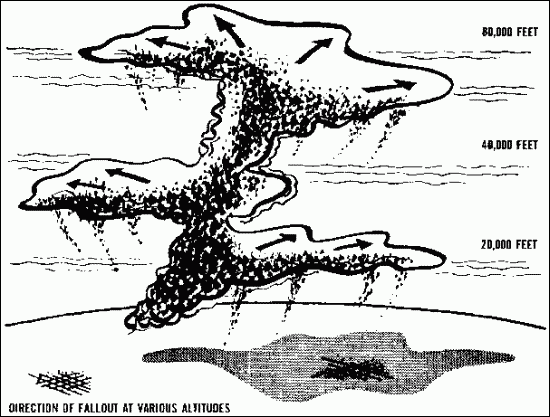
Direction of Fallout at Various Altitudes
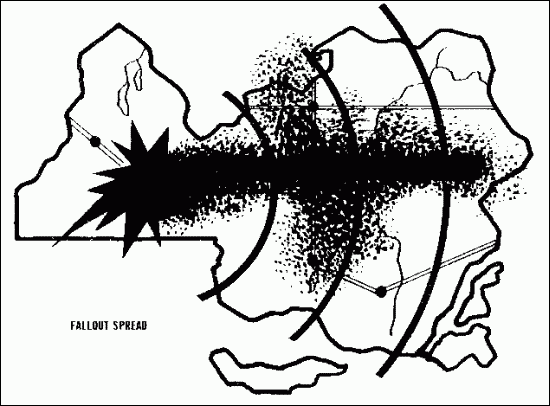
Fallout Spread
Time
The radioactivity in fallout weakens rapidly in the first hours after an explosion. This weakening is called “decay”. After seven hours, fallout has lost about 90% of the strength it had one hour after the explosion. After two days it has lost 99%; in two weeks 99.9% of its strength is gone. Nevertheless, if the radiation at the beginning were high enough, the remaining 0.1% could be dangerous.
Radiation must be measured by special instruments handled by people trained to use them. But, if you stay in a shelter during the first days following an explosion, you escape the strongest radiation. You should stay in the shelter until radiation has been measured and you have been told aver the radio that it is safe to come out.

Radiation Decay Time
Distance
The strength of radiation reaching your body is reduced the farther you are from the fallout. Here are some illustrations of the safest place to be when you are in various kinds of buildings.
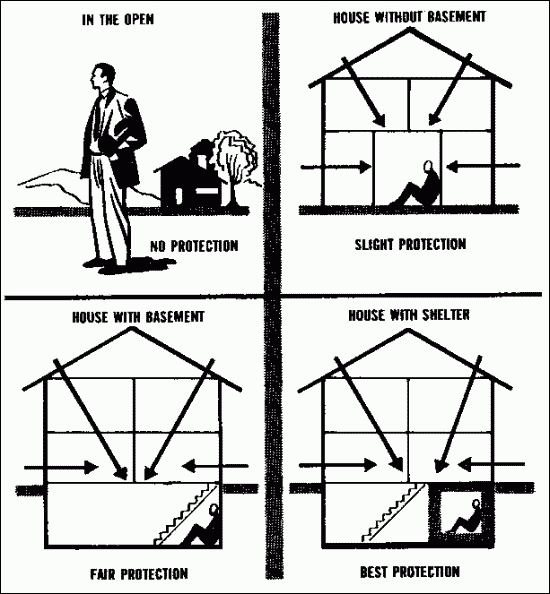
Distance Shielding
The most effective protection is to place some heavy material between yourself and the fallout. The heavier the material the better the protection. Many common materials give excellent protection. The materials and design of the fallout shelter recommended in Blueprint for Survival No. 1 will stop penetration of 99% of outside radiation.
These thicknesses of material will stop 99% of radiation:
- 16 inches of solid brick
- 16 inches of hollow concrete blocks filled with mortar or sand
- 2 feet of packed earth Ä 3 feet if loose
- 5 inches of steel
- 3 inches of lead
- 3 feet of water
A fallout shelter is the best way to protect your family and yourself against radiation because:
- It keeps the radiation at a distance
- It shields you from radiation.
- The time spent there is the period when radiation is most intense.
By providing your family and yourself with a fallout shelter, you are unlikely to suffer serious effects from radioactive fallout.

Shielding
http://autonopedia.org/survival/Eleven_Steps_To_Nuclear_Survival.html
________________________________________________________________
NUCLEAR STRIKE MATERIAL FROM MUSHROOM CLOUD
Mach stem video
VIDEO: MACHSTEM Dailymotion | AtomicArchive
If the explosion occurs above the ground, when the expanding blast wave strikes the surface of the earth, it is reflected off the ground to form a second shock wave. This reflected blast wave can merge with the incident shock wave. This merging phenomenon is called the “Mach effect”. The overpressure at the front of the Mach wave is generally about twice as great as that at the direct blast wave front. This footage is from a conventional explosion.
Ground Zero
Video of Hiroshima
VIDEO: HIROSHIMA Dailymotion | Atomicarchive
Video of damage at Hiroshima
VIDEO: Hiroshima Damage Dailymotion | Atomicarchive
VAPORIZATION
FROM: America’s Reaction to the Atomic Bomb
Hiroshima
“Any object within a two kilometer distance from the hypocenter [at Hiroshima] suffered significant burn damage, and those located near the hypocenter were instantaneously vaporized. The Shima hospital, the hypocenter of the atomic bomb was vaporized, along with all her patients.”
http://users.dickinson.edu/~history/product/steele/seniorthesis.htm
Nagasaki
Yukiharu did not realize at first that a bomb had exploded. He thought there had been an electrical accident at the plant building he was working in. Then it suddenly became dark and “I heard a huge explosion. The roof of the building had collapsed, and we were under the broken roof. I felt a pain in my head. I managed to escape from the building. I did not know what was happening to us, because we had not experienced any serious bombing [..] I was not badly hurt [..] A piece of broken glass was sticking into my head.”
http://users.dickinson.edu/~history/product/steele/seniorthesis.htm
Patricia Ondrovic Interview – Motorola Radio Troubles and Cellphone Problems
Killtown: After you witnessed the explosions in the lobby of the WTC 6, you started running in which direction and then what happened?
Patricia Ondrovic: I kept running west on Vesey. I got hit with the cloud shortly after being turned away from 6 WTC. I was probably at the corner of Vesey/West Street at that point running. I ran towards the West Side Highway — there is a park area there. I remember running across grass and there was now lots of gray and black smoke. I was just trying to get to the water because nothing was exploding, or on fire from what I could see. There were lots and lots of people also running that way at this point.
Killtown: When were you able to escape the dust cloud and what happened after that?
Patricia Ondrovic: I was now at the water’s edge. There were no boats I could see, so I started to run north along the side of the West Side Highway. I was about 9 or 10 blocks north of Vesey on the West Side Highway. I found the first FDNY EMS vehicle and knew the crew as they were also from my station. I remember not being able to breathe so well — felt like someone was standing on my chest. When I looked back, I could see people coming out of the black cloud and continuing to run and walk north on the West Side Highway as well.
Killtown: Did you notice any firefighters or other rescuers having technical problems with their Motorola radios or any other equipment?
Patricia Ondrovic: Oh yeah, at one point there was a loud “buzzing” sound and none of the EMS radios worked for maybe 30 seconds? We all used Motorola radios and I believe our repeaters were on top of the towers, so when the tower came down our radios failed. I tried to use my cellphone, but that too did not work.
Killtown: Do you know if anybody’s cellphone worked and were able to get through to anybody?
Patricia Ondrovic: A few of my co workers had Nextel phones. Theirs worked, but they couldn’t talk to anyone who didn’t have a Nextel because all the other services were out at the time.
http://killtown.blogspot.com/2006/02/911-rescuer-saw-explosions-inside-wtc.html


